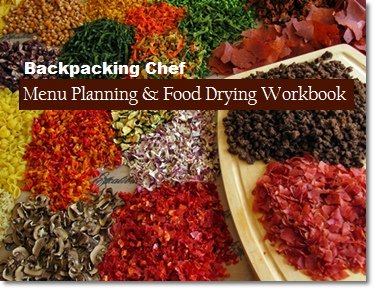Guide to Dehydrating Potatoes
This guide to dehydrating potatoes shows how to select, prepare, and cook potatoes before drying them. You’ll learn how to dehydrate potatoes by cutting them into cubes, thin slices, and French fry shapes, as well as how to dehydrate mashed potatoes, grated potatoes, and potato skins.
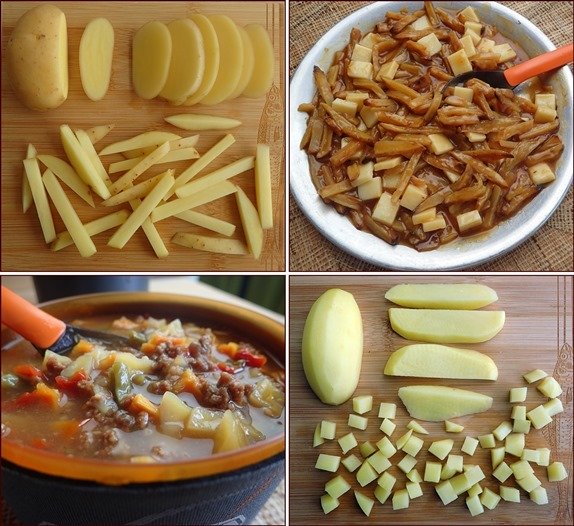
Dehydrated potato recipes on this page include French fries & gravy, potatoes au gratin, cheesy creamed potatoes & chili, vegetable beef soup with potatoes, and grated potatoes with meat & vegetables.
Table of Contents
How to Dehydrate Sliced Potatoes & Cubed Potatoes
Dehydrating Baked French Fries
Dehydrated Potato Storage & Shelf Life
Dehydrated Potato Recipes:
Vegetable Beef Soup with Potatoes
French Fries & Gravy with Cheese
See also: Potato-Fish Chowder
Part II:
Best Potatoes for Dehydrating
Any type of potato can be dehydrated. Russet potatoes are best reserved for dehydrating mashed potatoes, because they don’t hold their texture as well as other types of potatoes when cut and cooked in cube shapes or thin slices before they are dried.
White, yellow, red, and purple potatoes have firmer flesh and thinner skins than russet potatoes. They hold their shape and don’t get mushy when cooked before drying. These potatoes can be dried with the skin on or off. Thin potato skins make excellent snacks or toppings when peeled, seasoned, and dried. You may also find that white and yellow potatoes are less starchy when mashed and dehydrated.
Look for potatoes ranging in size from 1–1½ inches wide to 2–3½ inches long. The size of the potato will determine the best way to cut it.
Avoid dehydrating potatoes that are immature and have partly green skins. On the other end, don’t dry old potatoes the feel squishy or have buds spouting from them.
Dehydrating potatoes is an excellent alternative to using pasta in backpacking meals for people who want a gluten-free, healthy source of carbohydrates. Cooked potatoes provide 17 grams of carbohydrate per 100 grams, compared to 25 grams of carbohydrate for cooked pasta.
The nutritional profile of all potatoes is similar: They are nutrient dense and good sources of vitamins C and B6, potassium, iron, and fiber. Source: Potatoes USA: Potatoes & Nutrition.
How to Dehydrate Sliced & Cubed Potatoes
Wash & Peel
Wash and dry potatoes before cutting or peeling them. Peeling is optional.
Slice
The key to dehydrating sliced potatoes that finish drying at the same time is to slice them thinly and as close as possible to the same width.
Shoot for slices between ⅛-inch up to ¼-inch thick (½-cm), or cubes no larger than ½-inch thick (1 cm).
For potatoes that are an inch or less in width, slice them crosswise.
For wider potatoes, make a first cut longwise down the center.
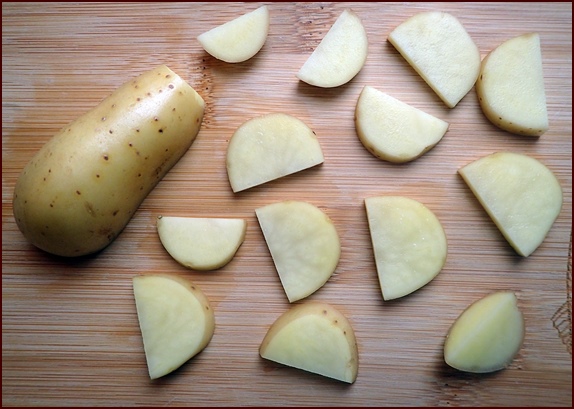
The Half-Moon Cut: After cutting the potato in half longwise, turn the potato onto its cut side and slice crosswise ⅛-inch up to ¼-inch thick (½-cm).
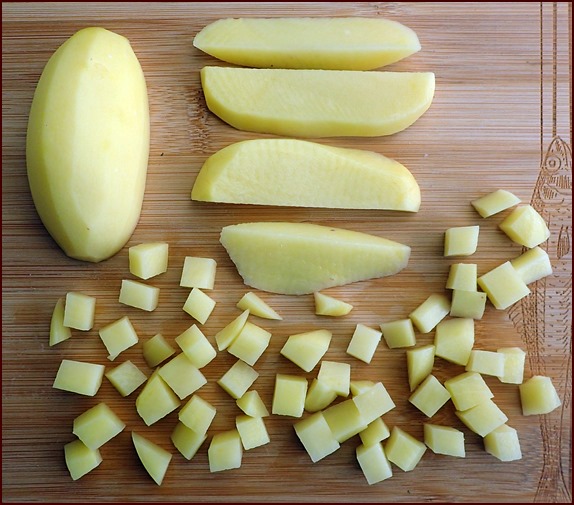
The Cube Cut: After cutting the potato in half longwise, turn the potato onto its cut side and make 3 cuts longwise ½-inch or less thick each (1 cm). Then, cut each of those pieces into ½-inch wide strips. Lastly, make ½-inch crosscuts to make cubes.
Soak & Rinse
As you cut the potatoes, drop the cut pieces into a bowl of cold water. This will prevent oxidation, and it will also remove some of the starch from the potatoes. When you are finished cutting, swirl the potatoes around once, pour off the water, rinse one time under cold water, and drain the potatoes in a colander.
Steam
Place cut potatoes in a pot inside a steamer basket with ½-inch of water in the bottom.
Steam for 6 minutes. Steaming for much longer may result in the slices falling apart.
After 6 minutes, drop the potato pieces into a bowl of cold water to stop the cooking process. Drain and dehydrate.
Dehydrating Potatoes—Sliced or Cubed
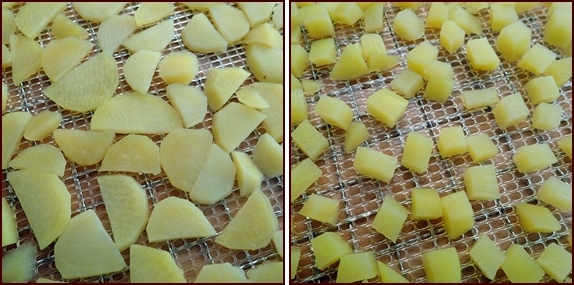
Photo: Dehydrating potatoes after slicing or cubing.
Place potatoes directly on dehydrator mesh sheets in a single layer, leaving a little space between them.
Dehydrate potatoes at 135°F (57°C) for 6–8 hours. Potatoes will be almost translucent when dry with a light-golden hue. They will be hard, not pliable.
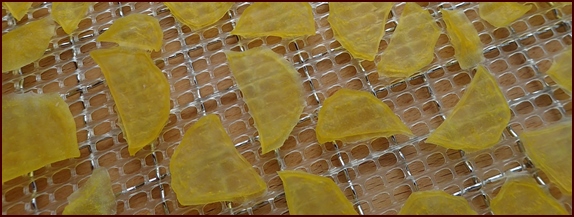
The potatoes in the photos above and below were dry in 6 hours using a Cosori dehydrator. Five hundred grams of potatoes (before steaming) were spread on 2 trays.
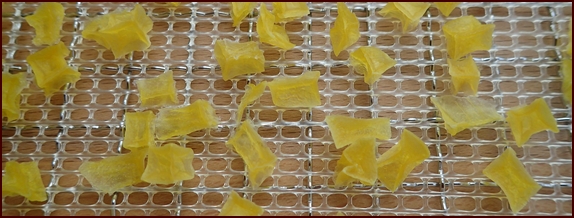
Yield: 500 grams of sliced or cubed potatoes (before steaming) weigh approximately 80 grams after dehydrating. Dried volume is approximately 1½ cups.
Potatoes au Gratin
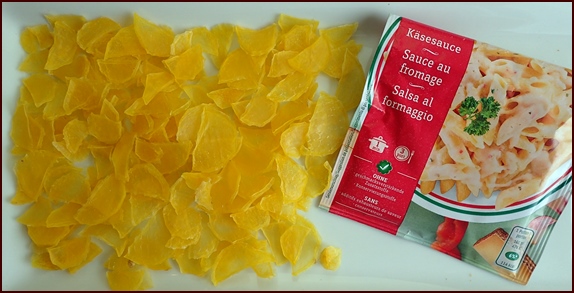
Servings: 1
Ingredients:
- ¾ cup dried sliced potatoes (40 g)
- 2 Tbsp. cheese sauce powder
- 1 cup water to rehydrate (237 ml)
This meal can be enhanced with extra ingredients like dried chives or bacon bits. It can also become a more substantial meal with the addition of dried meats and vegetables. Increase water 1:1 to compensate for added dry ingredients.
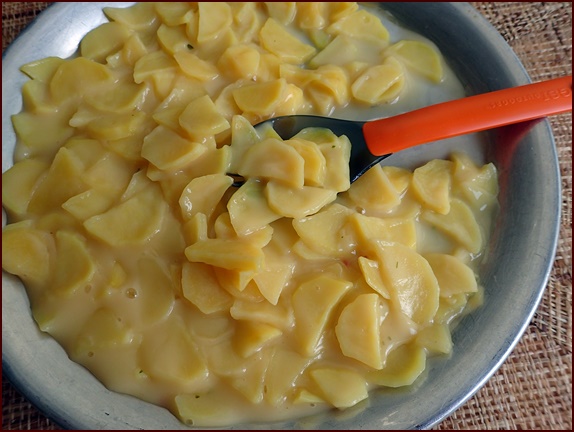
Photo: Rehydrated Potatoes au Gratin.
On the Trail:
Soak dried potato slices in cold water for 10–15 minutes. Stir in cheese sauce powder and light stove. Bring to a light boil, stirring continuously for 1 minute. Cover pot and transfer to an insulating cozy for 10-15 minutes.
Vegetable Beef Soup with Potatoes
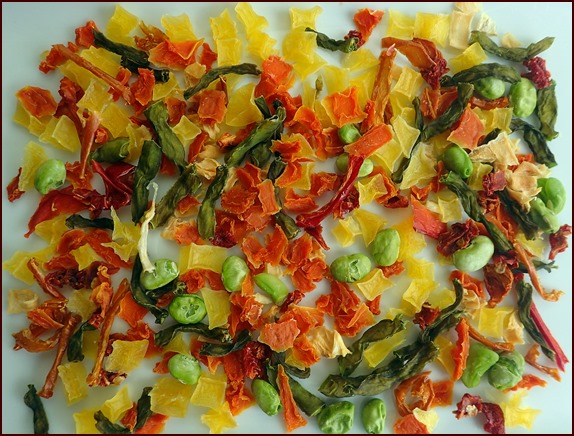
Photo: Dried potato cubes and mixed vegetables.
Servings: 1 large or 2 small
Ingredients:
- ½ cup dried mixed vegetables (30 g)
- ¼ cup dried ground beef (30 g)
- ¼ cup dried potato cubes (20 g)
- 2½ Tbsp. brown gravy mix powder
- 2½ cups water to rehydrate
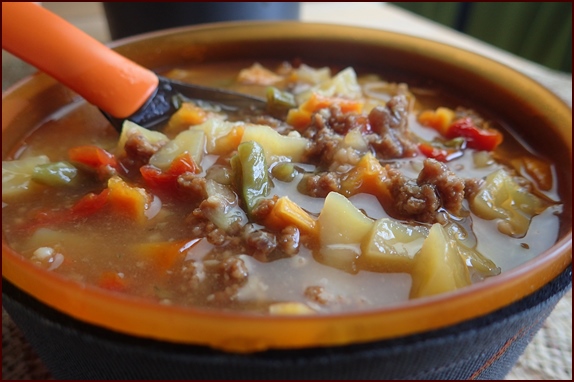
Photo: Enjoy a bowl of hot soup as your reward for dehydrating potatoes.
On the Trail:
Soak dried ingredients in cold water for 10 minutes. Add gravy powder and bring to a boil for 1 minute. Cover pot and transfer to an insulated cozy for 15–20 minutes. Soup can also be prepared in a thermos food jar by adding the boiled water to the dried ingredients in the thermos.
Dehydrating Baked French Fries
There’s no oil or frying involved in dehydrating these French “fried” potatoes, but you will be amazed at how similar they taste when they are steamed, seasoned, and baked.
They are snappy when dry, so they make great hiking snacks. Go full-diner mode and rehydrate them with brown gravy mix. Imagine… French fries and gravy on the trail, or what is called “poutine” in Canada, with cheese on top.
Wash
Wash and dry white or yellow potatoes that are approximately 3-inches long (8 cm). Leave the skins on.
Slice
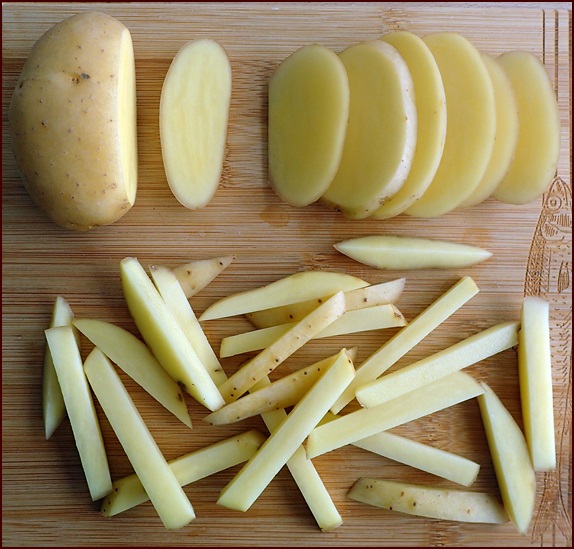
Make an initial longwise cut ¼-inch thick on one side of the potato (slightly more than ½-cm). This will stabilize the potato to make the rest of the longwise cuts easier.
Turn the potato onto its cut side and make similar, longwise ¼-inch thick cuts.
Cut each slice into ¼-inch thick fry shapes.
Soak & Rinse
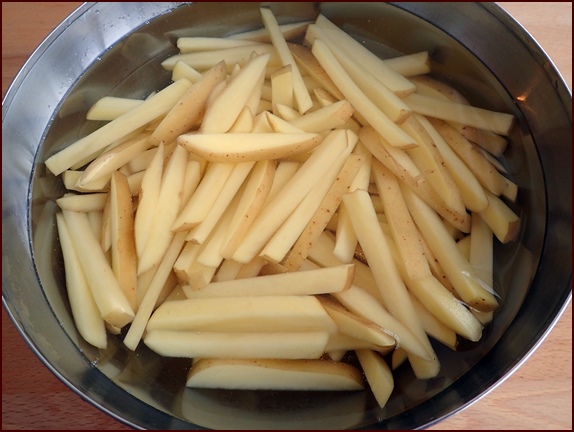
As you cut the fries, drop them into a bowl of cold water. Swirl the fries around once and drain the potatoes in a colander.
Steam
Steam fry-cut potatoes for 6 minutes in a steaming basket. The fries may fall apart if steamed longer.
After 6 minutes, drop the steamed fries into a bowl of cold water to stop the cooking process. Drain and season.
Season
Season these fries with your favorite herbs and spices. A small amount of vinegar really makes them delicious. Use white, malt, or apple-cider vinegar.
Chef Glenn’s Fry Seasonings:
- 500 g fry-cut potatoes
- 1 Tbsp. vinegar
- 1 tsp. salt
- 1 tsp. dried rosemary
- ¼ tsp. paprika
- ¼ tsp. onion powder
Add the vinegar and seasonings to the damp fries in a bowl. Stir gently to mix and let them sit a few minutes before baking them.
Bake
Preheat oven to 425°F (218°C).
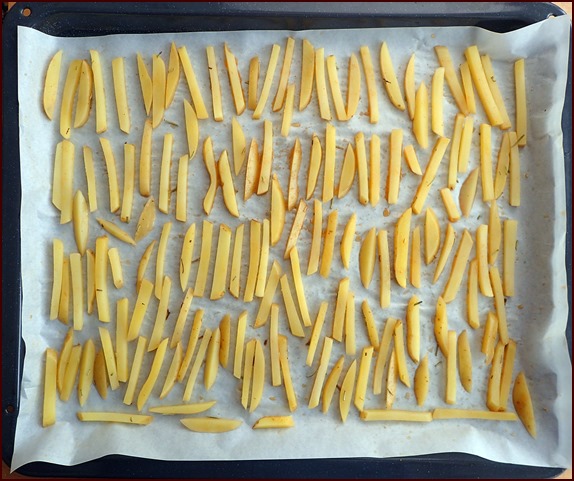
Photo: 250 grams of potatoes on a baking tray.
Spread steamed and seasoned fries on a baking tray covered with parchment paper. Leave a little space between them.
Bake for approximately 12 minutes on the middle rack. Since ovens may behave differently, check potatoes at 10 minutes to make sure they are not turning dark brown. In some cases, you might let them bake for 15 minutes. What you want is a nice golden-brown color, not dark brown, as that will impart a burnt taste. The edges will be slightly crispy and a little darker than the inner parts of the fries.
Caution: Hot steam may come out of the oven when you open it.
Dehydrate
Dehydrate fry-cut potatoes at 135°F (57°C) on mesh sheets for 7–9 hours until crispy. Dried fry-cut potatoes will easily snap in half and are excellent for snacking.
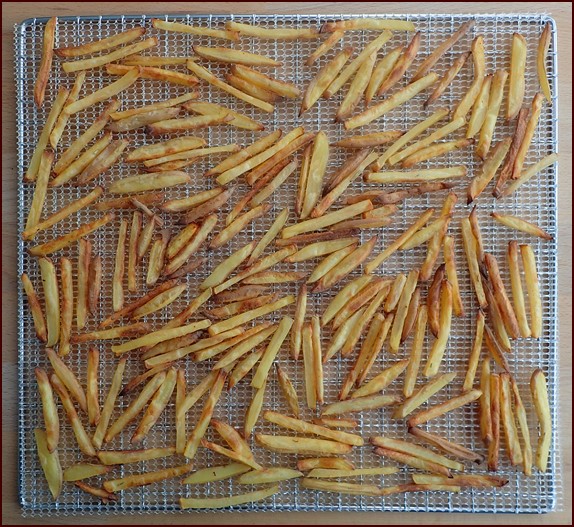
Photo: Dehydrating potatoes directly on mesh sheet of Cosori dehydrator. 250 grams of fry-cut potatoes were dry in 7 hours.
Yield: 500 grams of fry-cut potatoes (before cooking) will weigh approximately 95 grams when dry.
Snacking Idea:
You don’t have to rehydrate these fries to enjoy them. Pack a handful of dried fries in a Ziploc bag and enclose a single-serving packet of your favorite condiment—ketchup, mayo, tartar sauce, mustard, jelly, honey, peanut butter—anything goes on the trail. Dip and be happy!
French Fries & Gravy with Cheese
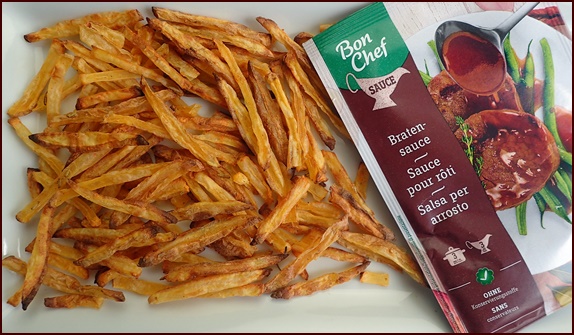
In Canada, this specialty is called poutine. Canadians top their French fries and gravy with cheese curds, but if you can’t find them in the store, any cheese will do.
Servings: 1
Ingredients:
- 1 cup dried fry-cut potatoes
- 2 Tbsp. brown gravy mix powder
- 1 cup water to rehydrate (237 ml)
- 1–2 oz. fresh cheese (40–60 g)
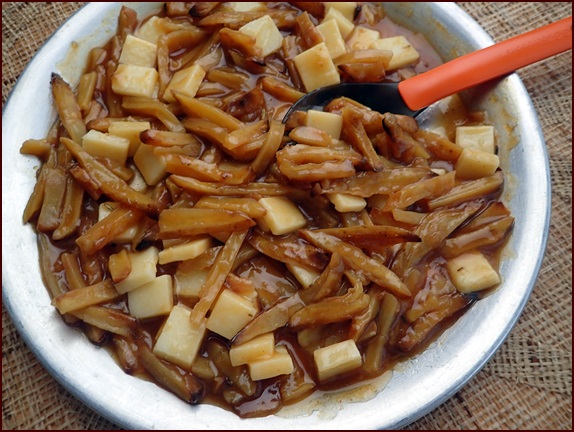
On the Trail:
Soak dried fry-cut potatoes in cold water for 10 minutes. Add gravy powder, turn on stove, and bring to a light boil, stirring continuously. Turn off stove, drop cheese on top, and transfer pot to insulating cozy for 10 minutes.
Dehydrating Grated Potatoes
Grated potatoes lend a “hash brown” texture to dehydrated backpacking meals. They go great with chili, sausage-seasoned ground beef and onions, or ham and sauerkraut.
Wash & Steam Whole Potatoes
Steam medium-size white potatoes with the skins on for 15 minutes. You want them to be fully cooked, but not too soft.
Drop the steamed potatoes into a pot of cold water to cool them, then remove the skins.
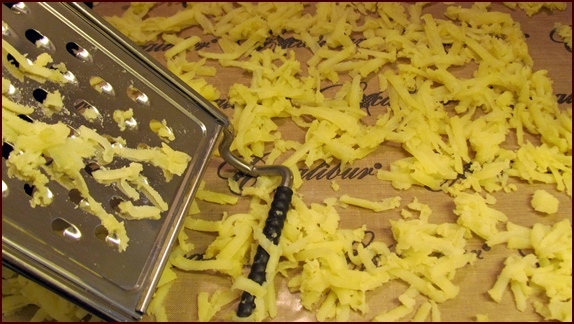
Photo: Dehydrating potatoes after grating onto nonstick sheet.
Using a coarse grater, grate the potatoes directly onto dehydrator trays covered with nonstick sheets. Move the grater across the dehydrator tray as you go to minimize having to separate the grated potatoes with your fingers. They will want to stick together, so a light touch with your fingers to finish spreading them around is best. If parts of your potatoes don’t grate well, just set them aside and eat them later. You will get a little of that when there is only a little bit of potato left between your fingers and the grater.
Dehydrate grated potatoes at 135°F (57°C) for approximately 6–8 hours until crispy. You can flip the potatoes over after 4 hours to speed drying. They will hold together like a mat. Break grated potatoes into smaller pieces when dry.
Yield: 900 grams of steamed and grated potatoes will weigh approximately 160 grams when dry, with a dried volume of approximately 2½ cups.
Grated Potatoes and Chili
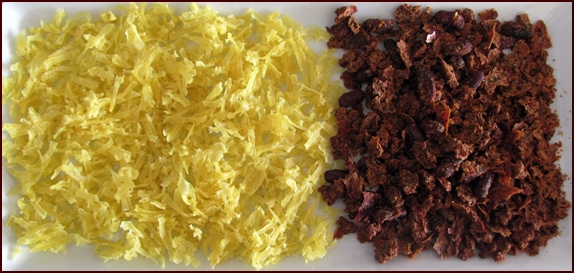
Servings: 1 large
Ingredients:
- ½ cup dried chili (45 g)
- 1 cup dried grated potatoes (64 g)
- 1¾ cups water to rehydrate (414 ml)
Here’s the recipe for dehydrated chili.
On the Trail:
Combine chili and grated potatoes with water in pot and soak for five minutes. Bring to a boil for one minute, transfer pot to an insulating cozy, and wait 10–15 minutes. Shake a little salt on meal as desired.
Alternatively, you can prepare this meal in a Mylar bag or thermos style by adding boiled water to the ingredients in the container. Wait about twenty minutes for best results. If preparing in a thermos for a meal that will be eaten several hours later, increase water by ¼ cup.
You’ll find more recipes for dehydrated grated potatoes in Recipes for Adventure II: The Best of Trail Bytes.
Dehydrating Potato Skins
If you peel your potatoes before drying them, don’t throw away the skins. They make delicious snacks or meal toppings when seasoned, baked, and dried. Thin potato skins work best.
As you peel the washed potatoes, drop the skins in a bowl of cold water until you are done processing the potatoes. Then drain thoroughly with a colander and return to the bowl.
For skins from 10–12 medium potatoes, stir in 1 teaspoon of vinegar (white, malt, or apple-cider) and season with spices and herbs of choice.
Chef Glenn’s Potato Peel Seasonings:
- 1 tsp. apple-cider vinegar
- ½ tsp. salt
- 1 tsp. dried rosemary
- ¼ tsp. onion powder
- ¼ tsp. garlic powder
- ¼ tsp. paprika
- ¼ tsp. chili mix powder
Bake
Preheat oven to 400°F (200°C).
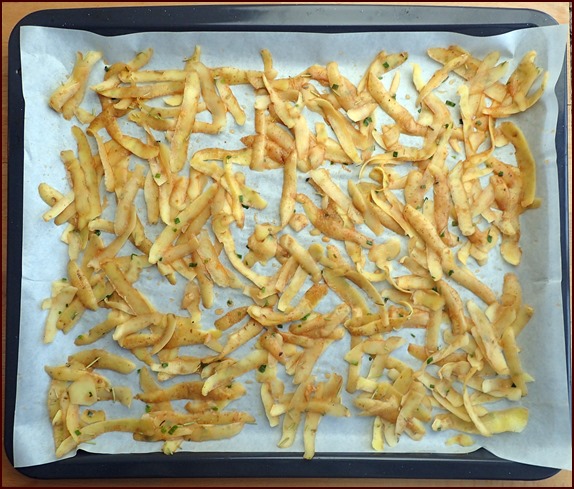
Spread peels out on baking tray covered with parchment paper. Bake on middle rack for approximately 15 minutes, but keep an eye on them so they don’t burn. They will be almost dry and crispy when done.
Stir peels at 6 and 12 minutes.
Caution: Hot steam may come out of the oven when you open it.
Dehydrate Potato Skins
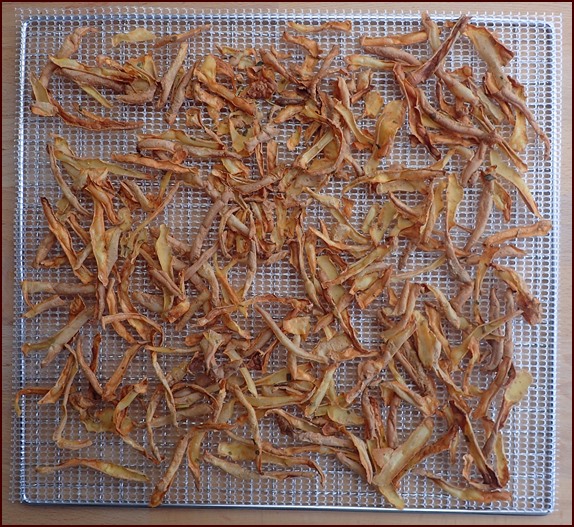
Transfer the skins directly to mesh sheet of dehydrator tray.
Dehydrate potato skins at 135°F (57°C) for approximately 4 hours. Dried peels will be crispy.
Snack on them out of a bag, or use them as a topping for backpacking meals.
Dehydrated Potato Storage & Shelf Life
Since potatoes are a fat-free food, there is no risk of them going rancid in storage. They will easily last 2 or more years if dried thoroughly and stored in an air/moisture tight container. Nevertheless, best practice is to use dried potatoes and other home-dehydrated foods within 1 year for best results.
For home storage, mason jars work well to seal out moisture. Oxygen absorbers are optional.
For the trail, packing dried potato meals in Ziploc bags is fine for short trips, but vacuum sealing is recommended for longer trips or when adventuring in wet environments.
Explore More...
Part II: How to Dehydrate
Mashed Potatoes
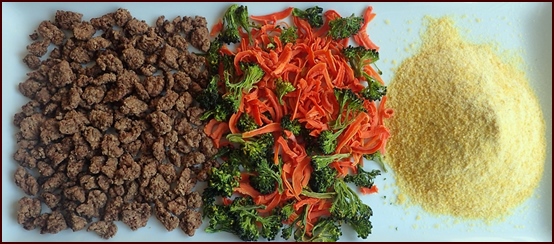
Photo: Dried and powdered mashed potatoes with dried ground beef and mixed vegetables.
Learn how to dehydrate mashed potatoes into instant mashed potato powder, and how to make potato bark and barbecue potato bark.
Share this page with friends on social media.
Free E-book & Newsletter
Free with Trail Bytes subscription.
Dehydrating Food from A–Z





